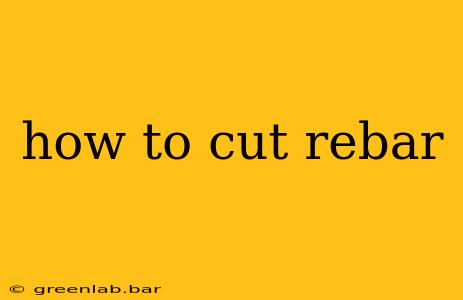Cutting rebar, or reinforcing steel, is a common task in construction and various DIY projects. However, it requires the right tools and techniques to ensure safety and a clean, precise cut. This comprehensive guide will walk you through different methods, safety precautions, and best practices for cutting rebar effectively.
Choosing the Right Tool for the Job
The best tool for cutting rebar depends on the diameter of the bar and the frequency of the task. Here's a breakdown of popular options:
1. Reciprocating Saw (Sawzall):
- Pros: Versatile, relatively inexpensive, good for various bar diameters.
- Cons: Can be slower for thicker rebar, requires a specific blade (bi-metal blades are recommended).
- Best for: Occasional cutting, smaller diameter rebar, demolition work.
2. Angle Grinder with Abrasive Cut-off Wheel:
- Pros: Fast and efficient, especially for thicker rebar.
- Cons: Generates significant sparks and heat, requires safety precautions (eye protection, gloves, etc.), can be noisy.
- Best for: Frequent cutting, larger diameter rebar, demanding projects. Always use a metal cutting wheel, never a concrete or masonry wheel.
3. Hydraulic Rebar Cutter:
- Pros: Extremely fast and clean cuts, minimal effort required, ideal for large-diameter rebar.
- Cons: Expensive, typically used by professional contractors.
- Best for: High-volume cutting, industrial settings, large-scale construction projects.
4. Rebar Shear (Hand Shear):
- Pros: Portable, no power source needed, good for smaller diameter rebar and quick cuts.
- Cons: Can be physically demanding, not ideal for thick rebar.
- Best for: Smaller jobs, occasional use by DIYers working with thinner rebar.
Safety First: Essential Precautions
Cutting rebar can be dangerous if proper safety measures aren't followed. Always prioritize safety:
- Eye Protection: Wear safety glasses or a face shield to protect against flying sparks and debris.
- Hearing Protection: Angle grinders and reciprocating saws are loud; earplugs or muffs are crucial.
- Gloves: Heavy-duty work gloves will protect your hands from sharp edges and hot metal.
- Respiratory Protection: In enclosed spaces, consider a dust mask to prevent inhaling metal dust.
- Proper Ventilation: Ensure adequate ventilation to disperse sparks and fumes, especially when using an angle grinder.
- Stable Work Surface: Securely clamp the rebar to a stable work surface to prevent accidental movement during cutting.
- Appropriate Clothing: Wear closed-toe shoes and clothing that won't get caught in the equipment.
Cutting Techniques: Step-by-Step Instructions
The specific steps may vary depending on the tool used, but here are general guidelines:
Using a Reciprocating Saw:
- Secure the rebar firmly.
- Choose the appropriate bi-metal blade.
- Start the saw and slowly cut through the rebar, using a steady motion.
- Allow the blade to do the work; avoid excessive pressure.
Using an Angle Grinder:
- Securely clamp the rebar.
- Wear appropriate safety gear (eye protection, gloves, etc.).
- Start the grinder and carefully guide the wheel against the rebar.
- Make smooth, controlled passes to avoid overheating the metal.
- Let the wheel do the cutting; avoid excessive pressure.
Using a Rebar Shear:
- Position the rebar within the jaws of the shear.
- Apply firm, even pressure to the handles.
- Close the shear completely to sever the rebar.
Post-Cutting Considerations
- Deburring: After cutting, use a file or grinder to remove any sharp burrs or rough edges to prevent injury.
- Disposal: Dispose of rebar scraps responsibly, following local regulations.
Conclusion
Cutting rebar effectively and safely requires the right tools, techniques, and a strong emphasis on safety. By following these guidelines and choosing the appropriate equipment for your project, you can ensure clean, precise cuts while minimizing the risk of injury. Remember, always prioritize safety—it's the most important aspect of any cutting task.

